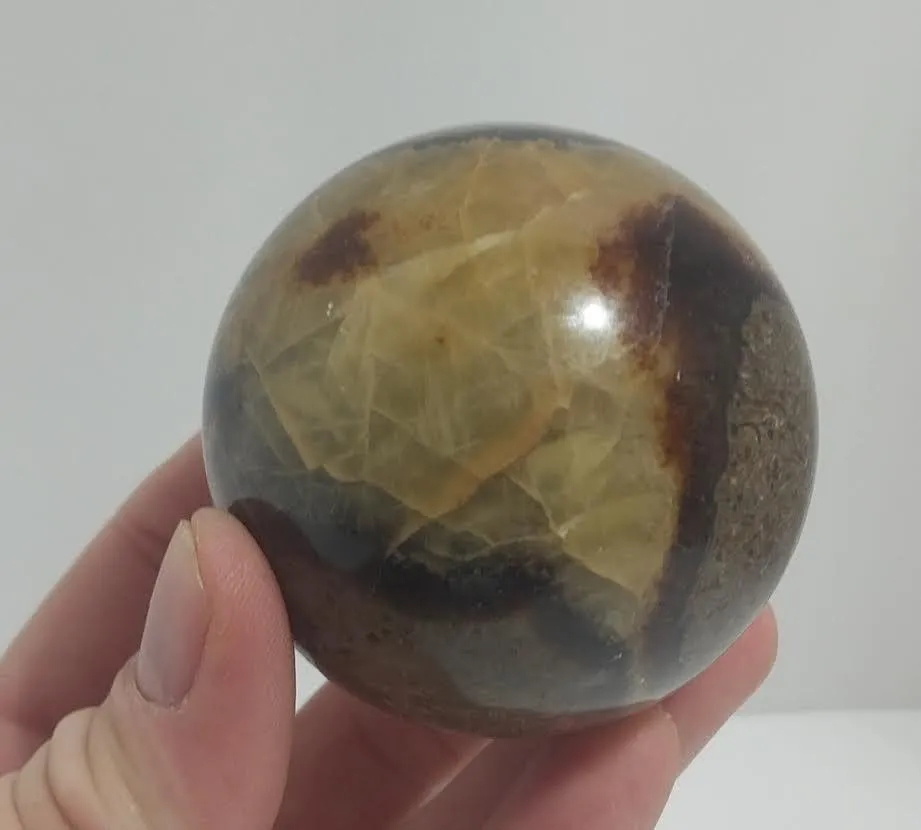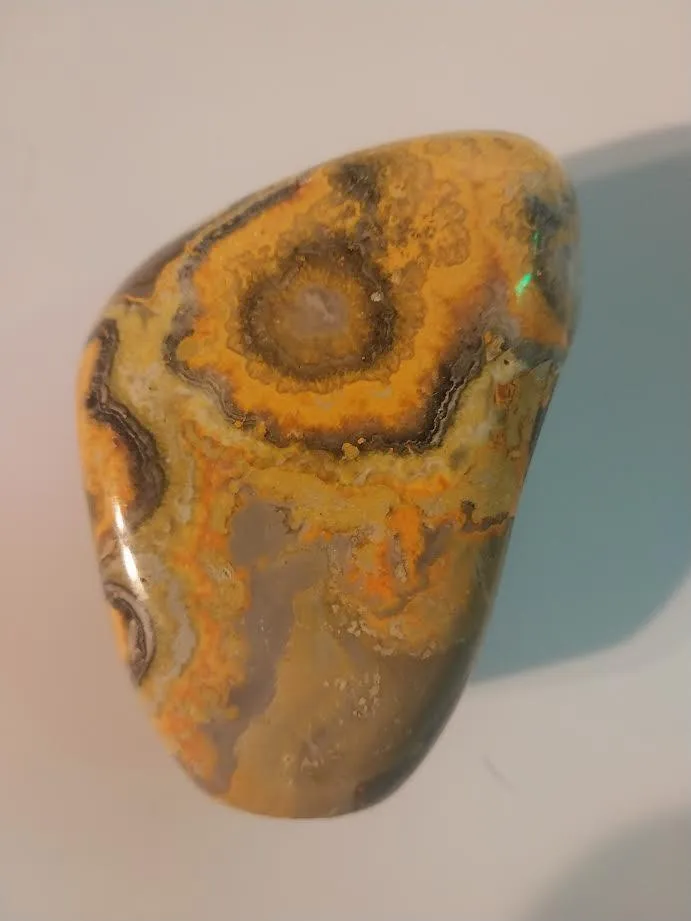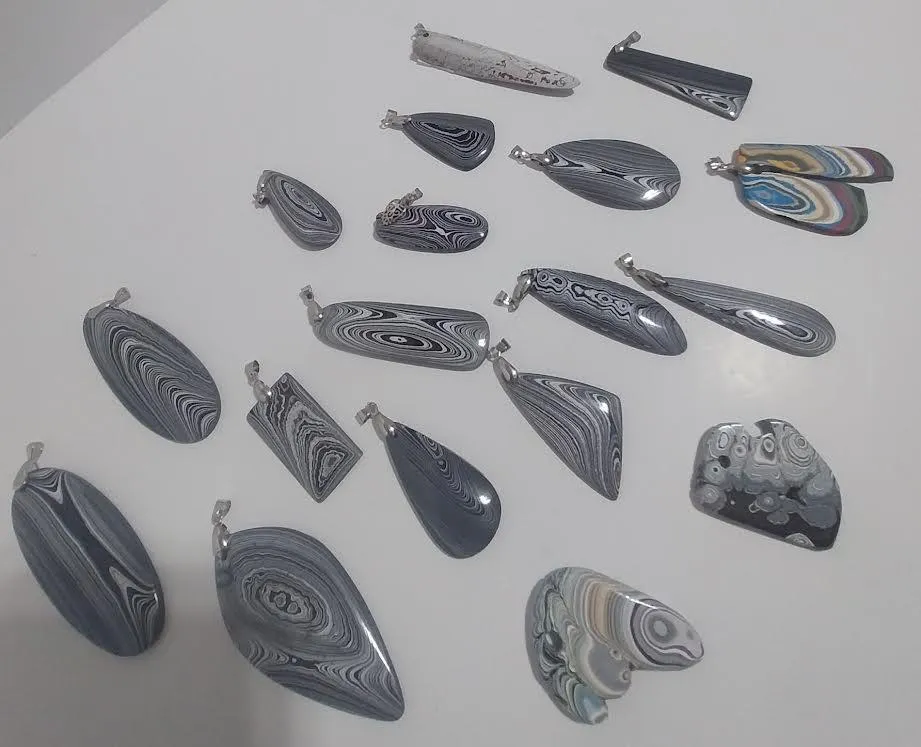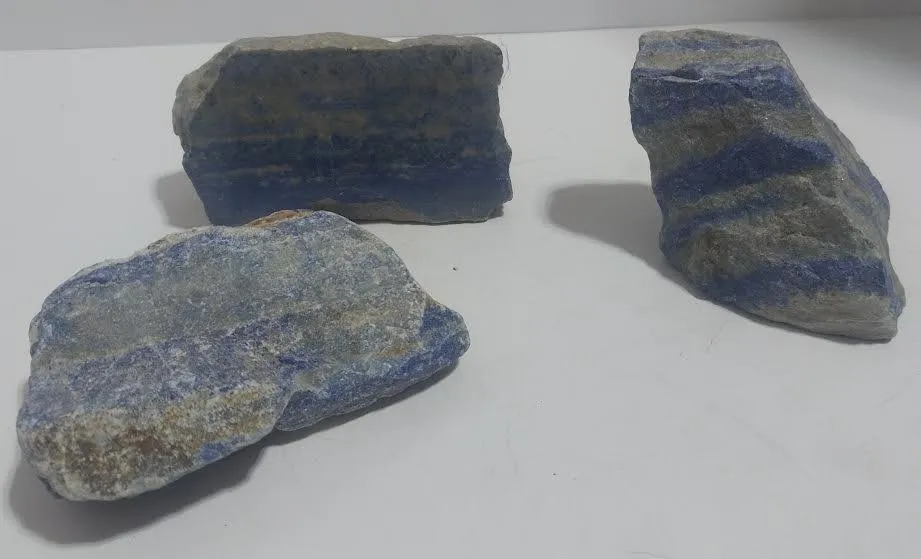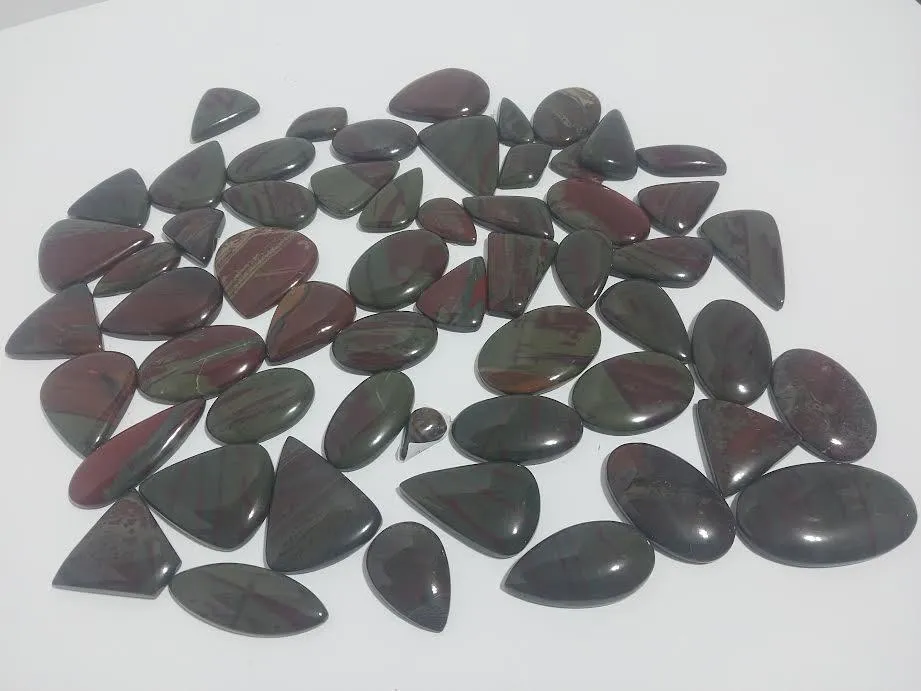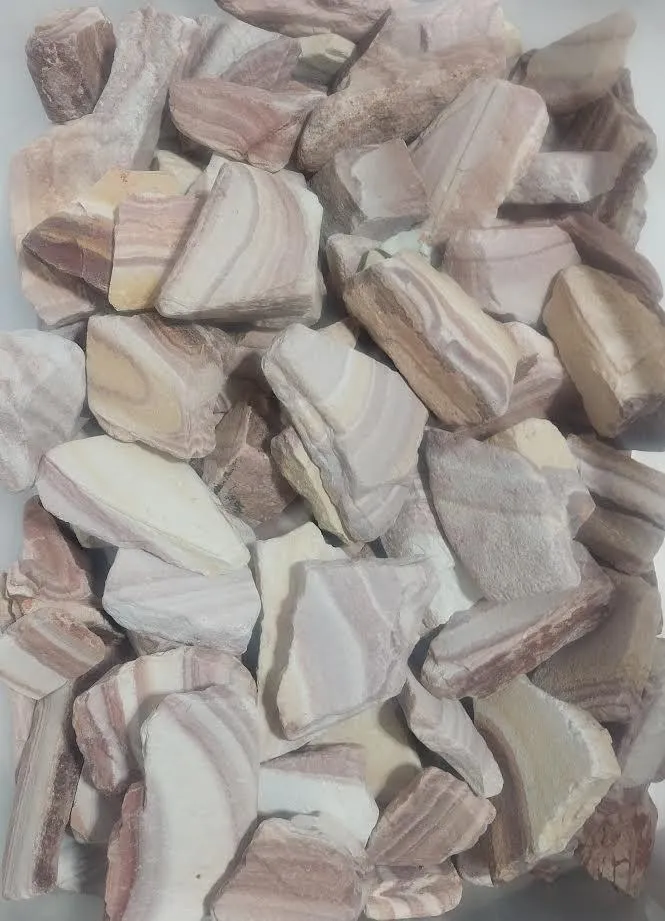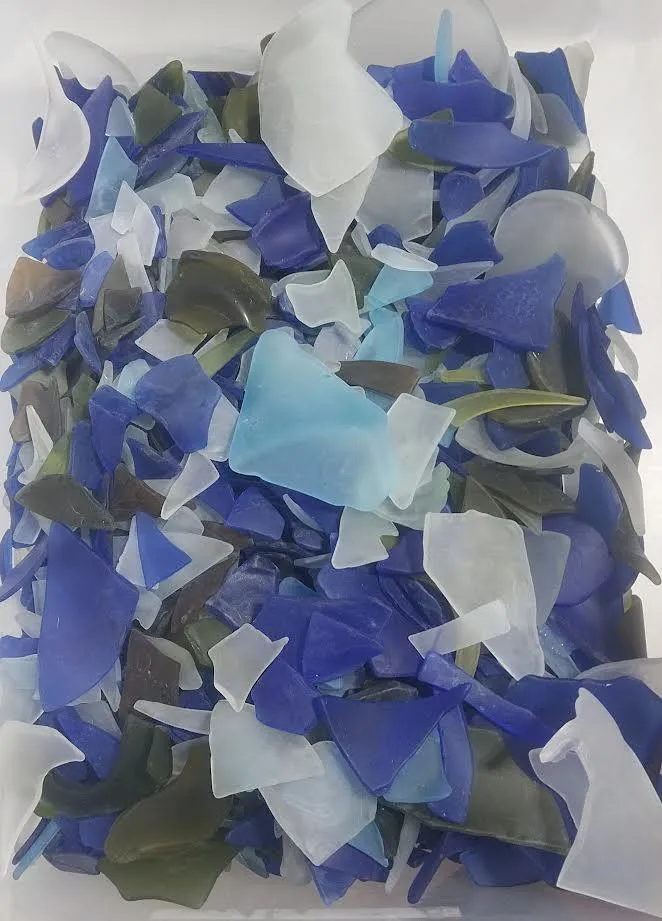Rocks and Gemstones
Welcome to the mesmerizing realm of rocks and gemstones. Our collection unveils the natural beauty of these treasures in their purest forms - from raw and unrefined specimens to meticulously polished and intricately carved masterpieces. Each stone and gemstone in our curated selection tells a geological tale, showcasing a spectrum of colors, patterns and textures.
Showing In Stock Variants
Tigers Eye
Tiger's Eye is a captivating and dynamic gemstone renowned for its unique optical phenomena and striking appearance. This chatoyant mineral is a form of quartz that typically exhibits a mesmerizing play of light across its surface, resembling the eye of a tiger, hence its name. The stone's distinctive golden to reddish-brown coloration, interspersed with bands of reflective sheen, adds to its allure. Tiger's Eye is prized not only for its aesthetic beauty but also for its believed metaphysical properties. It is often associated with qualities like courage, focus, and protection. As a popular choice for jewelry and ornamentation, Tiger's Eye is cherished for its ability to bring a sense of strength and clarity to those who wear or carry it. Whether in its raw, polished, or carved forms, Tiger's Eye stands as a symbol of resilience and empowerment, making it a cherished gemstone in the world of both aesthetics and holistic practices.
Fordite
Fordite, also known as "Detroit Agate," is a unique and fascinating material with a distinct origin. Contrary to traditional gemstones, Fordite is not formed in nature; rather, it is a man-made byproduct of the automotive industry. Originating from layers of enamel paint overspray that accumulated on the tracks and racks in automobile factories, Fordite showcases a kaleidoscope of colors and patterns resulting from the layering of different paint hues over time. Once these layers solidify, the material is cut, polished, and transformed into vibrant, multicolored cabochons or beads. Each piece of Fordite is a testament to the history of automotive craftsmanship, embodying the spirit of classic car manufacturing. Beyond its unique origin, Fordite is celebrated for its eco-friendly nature, repurposing waste into stunning and distinctive pieces of jewelry or collectibles. This rare and recycled gem serves as a creative and colorful link between the world of automobiles and the realm of artisanal craftsmanship.
Snake Skin Jasper
Snake Skin, also known as Snake Jasper or Snake Agate, is a captivating variety of chalcedony that exhibits patterns resembling the intricate scales of a snake. Its appearance is characterized by sinuous lines, undulating bands, and intricate markings, mimicking the texture and beauty of actual snake skin. This unique gemstone often features a combination of earthy tones, including browns, blacks, creams, and grays, contributing to its exotic and mysterious allure. Snake Skin is highly valued in the world of lapidary arts and jewelry design for its distinctive patterns and the organic elegance it brings to accessories. Beyond its aesthetic appeal, Snake Skin is believed by some to possess grounding properties and is associated with transformation and shedding old habits, much like the symbolic shedding of snake skin. Whether used in polished cabochons, beads, or carved into intricate shapes, Snake Skin stands as a testament to the beauty found in nature's patterns and the inspiration they provide to artisans and enthusiasts alike.
Bumblebee Jasper
Snake Skin, also known as Snake Jasper or Snake Agate, is a captivating variety of chalcedony that exhibits patterns resembling the intricate scales of a snake. Its appearance is characterized by sinuous lines, undulating bands, and intricate markings, mimicking the texture and beauty of actual snake skin. This unique gemstone often features a combination of earthy tones, including browns, blacks, creams, and grays, contributing to its exotic and mysterious allure. Snake Skin is highly valued in the world of lapidary arts and jewelry design for its distinctive patterns and the organic elegance it brings to accessories. Beyond its aesthetic appeal, Snake Skin is believed by some to possess grounding properties and is associated with transformation and shedding old habits, much like the symbolic shedding of snake skin. Whether used in polished cabochons, beads, or carved into intricate shapes, Snake Skin stands as a testament to the beauty found in nature's patterns and the inspiration they provide to artisans and enthusiasts alike.
Moss Agate
Moss Agate is a captivating variety of agate renowned for its unique and picturesque appearance. Recognized for its translucent to opaque quartz base, Moss Agate is distinguished by the presence of green to blue-green inclusions that resemble delicate moss or fern-like patterns. These inclusions are composed of minerals such as chlorite or hornblende. The interplay between the clear or milky base and the intricate green formations creates a mesmerizing landscape within the stone.
Moss Agate is often associated with nature and is revered for its grounding properties. It is believed to bring balance, stability, and a connection to the natural world. The gemstone has been a popular choice for jewelry and decorative items for centuries, with its calming energy and unique appearance making it a favorite among artisans and collectors alike.
Whether fashioned into cabochons, beads, or carved into intricate shapes, Moss Agate showcases the delicate beauty found in the natural world. Its appearance evokes a sense of tranquility and harmony, making it not only a visually appealing gem but also one that carries a symbolic connection to the lush greenery of the outdoors.
Petoskey Stone
Petoskey Stone is a unique and iconic fossilized coral found in the northern regions of Michigan, particularly around the shores of Lake Michigan. Named after the city of Petoskey, this distinctive stone is recognized for its fossilized hexagonal coral patterns, resembling the intricate cells of a honeycomb. The stone itself is a type of fossilized rugose coral, Hexagonaria percarinata, which lived during the Devonian period, approximately 350 million years ago.
Petoskey Stones typically feature a grayish or brownish background with a network of lighter-colored hexagonal shapes. When polished, these patterns become even more pronounced, revealing the fossilized remnants of ancient marine life. Due to its unique appearance and geological significance, Petoskey Stone has become a cherished symbol of Michigan.
Artisans and collectors often transform Petoskey Stones into jewelry, polished cabochons, or decorative items. Beyond its aesthetic appeal, the stone carries a sense of history, connecting individuals to the ancient seas that once covered the region. As a cherished part of Michigan's geological heritage, Petoskey Stone stands as a fascinating and enduring link to the natural history of the Great Lakes area.
Selenite
Selenite is an exquisite and ethereal variety of gypsum known for its luminous appearance and fine crystalline structure. Named after the Greek moon goddess Selene, this translucent to opaque mineral often forms in delicate, transparent crystals that can resemble icicles or prisms. Selenite is commonly found in evaporative environments like deserts or caves, where it forms through the evaporation of water from sulfate-rich solutions.
One of the distinctive qualities of Selenite is its unique ability to appear to glow when exposed to light. This effect, known as "luminescence," gives the crystal a mystical and otherworldly aura. Due to its delicate nature, Selenite is often carved into wands, polished into smooth palm stones, or left in its natural crystalline form for decorative purposes.
Beyond its aesthetic appeal, Selenite is associated with various metaphysical properties. It is believed by some to possess qualities of clarity, purification, and connection to higher spiritual realms. Many use Selenite for meditation, energy cleansing, and promoting a sense of peace and tranquility.
Whether used for its aesthetic charm or its metaphysical properties, Selenite stands as a symbol of purity and illumination, inviting individuals to explore the mystical and serene aspects of the mineral kingdom.
Septarian
Septarian, also known as Septarian Nodules or Dragon Stone, is a distinctive and fascinating sedimentary rock characterized by its unique patterns and mineral composition. This geological wonder typically forms as a result of marine sedimentation processes and consists of a concretion of minerals, including calcite, aragonite, and barite. The name "Septarian" originates from the Latin word "septum," meaning partition, which refers to the distinctive cracks or separations that often radiate from the center of the nodules.
Septarian nodules are renowned for their captivating appearance, featuring a combination of yellow-brown calcite centers, grayish aragonite, and dark outer layers composed of mudstone or limestone. The intricate patterns within the nodules often create striking and complex designs, resembling the scales of a dragon or the outlines of a geological map.
Beyond its aesthetic appeal, Septarian is believed to carry grounding and nurturing energies. Many consider it a stone of emotional flexibility, resilience, and harmony. The unique combination of minerals within Septarian nodules contributes to its diverse range of colors and textures, making it a sought-after material for lapidary arts, sculptures, and decorative objects. Whether used for its visual allure or its perceived metaphysical properties, Septarian invites individuals to explore the ancient geological processes encapsulated within its captivating patterns.
Lapis Lazuli
Lapis Lazuli is a captivating gemstone with a rich history dating back thousands of years. Known for its intense blue color, often adorned with golden pyrite flecks, Lapis Lazuli has been highly prized for its beauty and symbolism. This metamorphic rock primarily consists of lazurite, but may also include minerals like calcite and pyrite.
Originating from the Persian word "lazhward," meaning blue, Lapis Lazuli has been used for ornamental and decorative purposes throughout ancient civilizations. Its distinctive deep blue hue has made it a symbol of royalty, honor, and spirituality. The golden pyrite inclusions within Lapis Lazuli resemble stars in the night sky, enhancing its celestial allure.
Artisans and jewelers have long utilized Lapis Lazuli in the creation of jewelry, amulets, and decorative objects. Its association with wisdom and truth in various cultural and spiritual traditions adds to its allure. Lapis Lazuli is also used in art, pigments, and cosmetics, with its powdered form known as ultramarine historically being a prized pigment.
Beyond its aesthetic appeal, Lapis Lazuli is believed to have metaphysical properties associated with enhancing self-awareness, intuition, and communication. As a gemstone that transcends time and cultures, Lapis Lazuli continues to be treasured for both its visual beauty and the deeper meanings it carries.
Charoite
Charoite is a mesmerizing mineral known for its distinctive purple color and intricate patterns. Russian Charoite, in particular, is highly esteemed for its exceptional quality and the unique geological conditions under which it is formed. This rare gemstone is found in the Chara River region of Siberia, Russia, and its name is derived from the river.
Russian Charoite typically exhibits a vibrant purple hue with swirling patterns of lavender, white, and black. The stone often showcases chatoyancy, a phenomenon where the colors appear to shift or shimmer as the stone is moved, adding to its visual appeal. Charoite is primarily composed of complex silicate minerals and is closely associated with the mineral nepheline.
Beyond its aesthetic beauty, Charoite is believed by some to have metaphysical properties that promote spiritual growth, transformation, and inner harmony. It is considered a stone of inspiration and insight, encouraging individuals to embrace change and face challenges with resilience.
Artisans often carve Russian Charoite into cabochons for jewelry, beads, or decorative objects, allowing its unique patterns and colors to be showcased. As a rare and captivating gemstone, Russian Charoite invites exploration into the geological wonders of Siberia and the beauty that emerges from the Earth's transformative processes.
Bloodstone (Heliotrope)
Bloodstone, also known as heliotrope, is a distinctive and ancient gemstone recognized for its dark green color adorned with red speckles or streaks, reminiscent of drops of blood. The primary mineral in bloodstone is green jasper, and the red spots are typically caused by the presence of iron oxide or hematite. This unique combination of colors gives bloodstone its name and contributes to its rich symbolism.
Historically, bloodstone has been valued for its talismanic properties, believed to bring strength, courage, and protection to its wearer. Its name "heliotrope" is derived from the ancient belief that the stone could turn the sun red when immersed in water. This belief, coupled with its association with healing properties, has contributed to the stone's enduring popularity.
Bloodstone is often used in lapidary arts to create cabochons for rings, pendants, and other jewelry pieces. Its deep green base and red speckles make it an eye-catching and unique gemstone. Additionally, bloodstone has been carved into amulets and figurines throughout history, reflecting its perceived protective qualities.
Whether appreciated for its aesthetic appeal or its historical significance, bloodstone stands as a gemstone steeped in tradition and symbolism, offering a connection to the past and a sense of strength and vitality to those who wear or admire it.
Wonderstone
Wonder Stones, true to their name, are captivating minerals that evoke a sense of awe and fascination. These extraordinary specimens, whether adorned with vibrant colors, unique patterns, or mystical properties, never fail to spark curiosity and admiration. Each Wonder Stone is a testament to the wonders of the Earth, showcasing the beauty hidden within the depths of the planet. From their mesmerizing aesthetic appeal to the potential metaphysical energies they may possess, Wonder Stones invite exploration and contemplation. Whether used as decorative pieces, meditation tools, or simply admired for their innate charm, Wonder Stones contribute to a sense of wonderment and connection with the profound mysteries of the natural world.
Chrysocolla
Chrysocolla is a captivating and vibrant mineral known for its stunning blue and green hues, often resembling the colors of the Earth's oceans. It is a hydrated copper silicate mineral that forms in the oxidation zones of copper ore deposits. The name "Chrysocolla" is derived from the Greek words "chrysos," meaning gold, and "kolla," meaning glue, possibly alluding to its historical use in soldering gold.
This mineral is often found in association with other copper minerals, such as malachite and azurite, contributing to its range of colors. Chrysocolla is prized for its distinctive appearance, displaying swirling patterns, concentric circles, or veining that add to its visual allure.
Beyond its aesthetic appeal, Chrysocolla is believed by some to have metaphysical properties associated with tranquility, communication, and empowerment. It is considered a stone that promotes harmony and balance, encouraging a connection with the Earth's energies.
Artisans frequently use Chrysocolla to create cabochons for jewelry, beads, and ornamental carvings. Its vibrant colors and unique patterns make it a popular choice for creating eye-catching and meaningful pieces. Whether appreciated for its aesthetic charm or its potential energetic qualities, Chrysocolla stands as a beautiful and meaningful addition to the world of gemstones and minerals.
Obsidian
Obsidian is a naturally occurring volcanic glass that forms when molten lava rapidly cools, often with minimal crystal growth. This rapid cooling prevents the formation of large crystals, resulting in a smooth and homogeneous glassy texture. Obsidian is typically dark in color, ranging from black to dark brown, and it may exhibit subtle variations and iridescence.
Obsidian has been used for various purposes throughout history, including as tools, weapons, and ornamental objects. The sharp edges of obsidian make it suitable for cutting and shaping, and ancient cultures utilized it for crafting tools such as blades and arrowheads.
In addition to its historical significance, obsidian holds cultural and spiritual importance. It is often associated with protection and grounding properties in metaphysical practices. Different types of obsidian, such as snowflake obsidian or rainbow obsidian, may exhibit unique patterns or colors, adding to their visual appeal.
Today, obsidian remains a popular material in jewelry, sculpture, and lapidary arts. Its sleek and dark appearance, coupled with its association with strength and protection, makes it a versatile and meaningful choice for both aesthetic and symbolic purposes.
Fulgurite
Fulgurite is a fascinating and rare type of natural glass that forms when lightning strikes sandy soil or other silica-rich materials. The intense heat generated by a lightning strike can cause the sand particles to melt and fuse together, creating tubular or branching formations known as fulgurites. These unique structures often have a hollow interior and can range in color from translucent to opaque.
The word "fulgurite" is derived from the Latin word "fulgur," meaning lightning. These formations capture the powerful moment of a lightning strike frozen in time. The size and shape of fulgurites can vary widely, and they are found in locations where lightning frequently occurs, such as sandy deserts, beaches, or areas with loose soil.
Fulgurites are sought after by collectors and enthusiasts for their rarity and the intriguing natural process that creates them. They are often used in jewelry, as decorative specimens, or as unique additions to mineral collections. The study of fulgurites also provides insights into the extreme conditions generated by lightning strikes and their effects on the surrounding environment. The delicate and intricate tubes of fulgurites serve as a captivating reminder of the powerful forces of nature.
Labradorite
Labradorite is a captivating and iridescent feldspar mineral known for its stunning play of colors, also known as labradorescence. This optical phenomenon occurs when light interacts with the fine layers of minerals within the stone, creating a vibrant display of spectral colors that shift and shimmer as the angle of observation changes. The predominant hues often include shades of blue, green, and gold, with flashes of other colors depending on the specific mineral inclusions.
Named after the Canadian province of Labrador, where it was first discovered, Labradorite is now found in various locations worldwide. Its distinctive iridescence sets it apart from other gemstones, making it a popular choice for jewelry and ornamental pieces.
Beyond its aesthetic appeal, Labradorite is associated with spiritual and metaphysical properties. It is believed by some to be a stone of transformation, protection, and intuition. Labradorite is often used in crystal healing practices to enhance spiritual awareness and balance energy.
Artisans and jewelers appreciate Labradorite for its unique visual effects, and it is commonly used in the creation of cabochons, beads, and other jewelry pieces. Whether admired for its mystical qualities or simply for its stunning play of colors, Labradorite continues to captivate those who encounter its mesmerizing beauty.
Beach Glass
Beach glass, also known as sea glass, is a beautiful and unique form of weathered glass that has been naturally tumbled and polished by the action of the waves and sand along coastlines. It starts as discarded glass, typically from bottles or other glass items, which finds its way into the ocean. Over time, the glass undergoes a natural process of erosion and abrasion, resulting in smooth, frosted surfaces.
One of the distinctive features of beach glass is its rounded and polished appearance, often exhibiting a matte or frosted texture. The original color of the glass can also change or fade during this process. Common colors of beach glass include green, brown, and white, but collectors may also find rarer hues like blue, red, or violet.
Beach glass holds sentimental value for many, as it represents a connection to the sea and the passage of time. It is popular among beachcombers and collectors who appreciate its natural beauty and the stories behind each piece. Some artisans use beach glass to create jewelry, home decor, or other crafts, celebrating the unique transformation of discarded glass into a cherished treasure by the sea.
Malachite
Malachite is a striking green mineral known for its vibrant color and distinctive banding patterns. It is a copper carbonate mineral and often forms in association with other copper minerals. The rich green color of malachite comes from the presence of copper ions in its composition. The mineral can be found in various shades of green, ranging from light green to deep emerald green.
One of the most notable features of malachite is its banded or concentric ring patterns, which create intricate designs resembling the rings of a tree. These patterns add to the visual appeal of malachite and make it a popular choice for both collectors and artisans.
Malachite has been used for centuries in jewelry, decorative arts, and ornamental objects. Its historical significance includes its use in ancient Egyptian jewelry and artifacts. The green hues of malachite are often associated with nature and are believed by some to have metaphysical properties related to transformation, protection, and emotional balance.
Artisans commonly use malachite to create cabochons, beads, and carvings for jewelry and sculptures. Despite its relative softness, malachite is highly valued for its unique aesthetics and the cultural and historical significance it carries. Whether appreciated for its natural beauty or its potential metaphysical properties, malachite remains a cherished and distinctive gemstone in the world of minerals.
Moonstone
Moonstone is a captivating and ethereal gemstone known for its enchanting play of light, also referred to as adularescence. This optical phenomenon creates a soft glow on the surface of the stone, reminiscent of moonlight passing through a thin cloud. Moonstone belongs to the feldspar mineral group and is valued for its unique appearance and gentle, milky sheen.
The most common color of moonstone is a translucent or milky white, but it can also be found in shades of peach, gray, blue, green, and brown. The stone's adularescence is often best observed in cabochon-cut specimens, where the play of light creates a shimmering effect across the surface.
Moonstone has a rich cultural and historical significance. In various traditions, it is associated with feminine energy, intuition, and the cycles of the moon. It has been used in jewelry for centuries and is often set in rings, earrings, necklaces, and other ornamental pieces.
Beyond its aesthetic appeal, moonstone is believed by some to have metaphysical properties related to enhancing intuition, promoting emotional balance, and connecting with the divine feminine. Whether appreciated for its symbolic significance or its alluring visual effects, moonstone remains a cherished and versatile gemstone in the world of jewelry and spiritual practices.
Zebra Marble
Zebra Marble is a distinctive and eye-catching variety of marble known for its striking black and white banding patterns, which resemble the stripes of a zebra. This unique visual characteristic is created by the presence of mineral impurities, such as graphite or manganese oxides, during the formation of the marble.
The black and white contrasts in Zebra Marble create a visually dynamic and aesthetically pleasing appearance. The patterns can vary from fine, intricate stripes to broader, more dramatic bands, making each piece of Zebra Marble unique.
This marble is often used for ornamental purposes, including sculptures, decorative tiles, and countertops, where its bold patterns add a touch of elegance and visual interest. The interplay of black and white in Zebra Marble makes it a versatile material for both contemporary and classic design styles.
Beyond its decorative uses, Zebra Marble has been associated with grounding and protective energies in some metaphysical traditions. Whether appreciated for its decorative appeal or its potential energetic properties, Zebra Marble stands out as a visually captivating and versatile natural stone.
Fossil Coral
Fossil Coral, also known as Agatized Coral, is a unique and intriguing form of fossilized coral that has undergone a process of mineral replacement. Over time, the original organic coral structure is replaced by agate, chalcedony, or other minerals, resulting in a beautifully preserved fossil with vibrant colors and intricate patterns.
The fossilization process begins when coral colonies die, and their skeletal remains become buried in sediment. Over millions of years, minerals from the surrounding environment gradually replace the coral's organic material, preserving the intricate details of the coral structure. The replacement minerals often impart a range of colors, including shades of red, pink, brown, and white.
Fossil Coral is appreciated for its ornamental and decorative uses, including the creation of cabochons for jewelry, beads, and carvings. The unique combination of fossilized coral patterns and the vibrant colors of the replacement minerals make each piece a distinctive and visually appealing treasure.
Beyond its aesthetic qualities, Fossil Coral is associated with grounding energy and connection to ancient life. Many people appreciate these fossils not only for their beauty but also for the glimpse they provide into the Earth's geological history and the remnants of ancient marine ecosystems captured within the stone.
Syenite (Yooper Light)
Syenite is a coarse-grained intrusive igneous rock composed primarily of feldspar, with lesser amounts of quartz, mica, and hornblende. It belongs to the category of plutonic rocks, meaning it forms beneath the Earth's surface through the slow cooling of magma. Syenite is characterized by its lack of free quartz and its dominant feldspar content, distinguishing it from granite, another common intrusive igneous rock. The rock's name is derived from the ancient city of Syene (now Aswan) in Egypt, where it was first described. Syenite has a variety of textures, ranging from aphanitic (fine-grained) to phaneritic (coarse-grained), depending on the cooling rate of the magma. Syenite can exhibit a range of colors, including shades of pink, gray, green, and white, depending on the mineral composition. It is often used as a decorative stone in construction and landscaping due to its durability and attractive appearance. The absence of quartz makes syenite less prone to weathering compared to granite. In addition to its practical applications, syenite is also of geological interest as it provides insights into the magmatic processes beneath the Earth's surface and the conditions under which it solidifies. Syenite, particularly a specific type found in the Upper Peninsula of Michigan, has earned the affectionate nickname "Yooper Light." The term "Yooper" refers to residents of the Upper Peninsula, and "Light" is derived from the distinctive light-colored appearance of the local syenite. This unique variation of syenite is notable for its pink, cream, and green hues, creating a visually appealing and characteristic stone. "Yooper Light" syenite is often used in various local applications, including construction, landscaping, and as a decorative material. Beyond its practical uses, the nickname reflects a sense of regional pride and connection to the geological treasures found in the Upper Peninsula. The term "Yooper Light" exemplifies the way in which local communities often develop affectionate monikers for the distinctive geological features that define their landscapes.
Rose Quartz
Rose Quartz is a beautiful and popular variety of the mineral quartz known for its delicate pink hue. The color ranges from pale pink to a deeper, more vibrant rose-pink. This gemstone is a result of trace amounts of titanium, iron, or manganese within the crystal structure. The soft, gentle color and translucent appearance contribute to the stone's romantic and soothing aesthetic.
Beyond its beauty, Rose Quartz has been revered for centuries for its associations with love and emotional healing. It is often considered a symbol of unconditional love, compassion, and peace. In various cultures, Rose Quartz has been used in jewelry, carvings, and decorative items as a talisman for matters of the heart.
Artisans frequently use Rose Quartz to create beads, cabochons, and carved figurines, while jewelers incorporate it into rings, necklaces, and other pieces to harness its positive energies. Some also believe that Rose Quartz has metaphysical properties that promote self-love, empathy, and harmony.
Whether appreciated for its cultural significance, believed healing properties, or simply its delicate beauty, Rose Quartz remains a beloved gemstone that transcends time and continues to hold a special place in the world of minerals and gemology.
Larimar
Larimar is a rare and beautiful gemstone known for its distinctive blue color reminiscent of the tranquil Caribbean waters. Also called the "Stefilia's Stone," Larimar is a variety of pectolite, a mineral that is not commonly found in gemstone-quality deposits. Larimar's unique coloring comes from the presence of copper impurities within the crystal lattice.
Discovered in the 1970s, Larimar is found exclusively in the Dominican Republic, particularly in the Bahoruco region. The gemstone can display various shades of blue, from light sky blue to deeper ocean blue, often with attractive marbling patterns and inclusions that resemble sunlight dancing on the water.
Larimar is celebrated not only for its captivating beauty but also for the spiritual and metaphysical attributes attributed to it. It is believed by some to have calming and soothing energies, promoting communication and emotional healing.
Artisans and jewelers often use Larimar to create unique and eye-catching pieces of jewelry, including rings, pendants, and earrings. Its rarity, coupled with its association with tropical waters, adds to the allure of Larimar as a cherished and meaningful gemstone.
Amethyst
Amethyst is a captivating and well-known variety of the mineral quartz, prized for its stunning purple coloration ranging from pale lilac to deep violet. The purple hues are a result of irradiation and the presence of trace amounts of iron and aluminum within the crystal lattice. Amethyst has been esteemed for centuries as a symbol of royalty and is often associated with qualities such as clarity of thought, spiritual insight, and balance.
The name "Amethyst" is derived from the Greek words "amethystos," meaning "not intoxicated." Ancient Greeks believed that wearing or drinking from vessels made of amethyst could protect one from drunkenness. This association with sobriety has continued throughout history.
Amethyst is found in various locations worldwide, with notable deposits in Brazil, Zambia, Uruguay, and Russia. The gemstone is often used in jewelry, and its versatility allows it to be cut into a variety of shapes, including faceted gems, cabochons, and beads.
Beyond its aesthetic appeal, amethyst is thought by some to have metaphysical properties promoting calmness, spiritual growth, and protection. Its soothing energy and rich color make amethyst a cherished gemstone in both the world of jewelry and the realm of holistic practices.
Ammonites
Ammonites, the captivating denizens of ancient seas, presented an awe-inspiring spectacle with their coiled shells. These marine mollusks, akin to the modern nautilus, showcased shells adorned with intricate patterns—a signature feature that defined their existence. The saga of ammonites unfolds over an expansive timeline, starting in the Devonian period some 400 million years ago. Flourishing through the Mesozoic Era, these resilient creatures bore witness to the eons, coexisting with dinosaurs and adapting to diverse marine landscapes. The Mesozoic Era's closure marked a poignant chapter for ammonites as they faced a significant decline during a mass extinction event about 66 million years ago. This catastrophic occurrence, often linked to an asteroid impact, brought an end to the reign of these marine marvels. Ammonites left an enduring mark in the fossil record, offering invaluable insights into Earth's ancient past. Fossils of these splendid creatures, meticulously preserved in sedimentary rocks, act as time capsules, aiding paleontologists in reconstructing ancient ecosystems. Beyond their scientific importance, ammonites resonate with metaphysical and symbolic meanings. Some view these fossils as vessels of transformative energy, connecting individuals to the wisdom embedded in the spirals of time. Unearth the secrets of the ancient seas with ammonites—a symbol of enduring beauty and a fascinating glimpse into the eons of Earth's evolutionary tapestry. At Unearthed Creations, our curated collection pays homage to these timeless treasures, bringing the allure of ammonites to modern admirers.
FAQS
How Much is Shipping?
With custom products shipping is calculated by weight. After an order is received, we will contact you during processing to show the shipping charges issued to us.
Do you offer custom jewelry design services, and how does the process work?
Yes, we offer custom jewelry design services to bring your unique vision to life.
Our process is simple: Schedule a consultation with our experienced artisans to discuss your ideas.
Design Concept: Our designers will create a concept based on your preferences and budget.
Approval: Review and approve the design concept before production begins.
Craftsmanship: Our skilled craftsmen bring your design to life using the finest materials.
Quality Assurance: Each custom piece undergoes rigorous quality checks.
Delivery: Your one-of-a-kind jewelry is delivered to you, ready to be treasured.
What is your return policy if I'm not completely satisfied with my purchase?
We want you to be delighted with your purchase. If for any reason you're not satisfied, we offer a hassle-free return policy. Ask us about the details!



